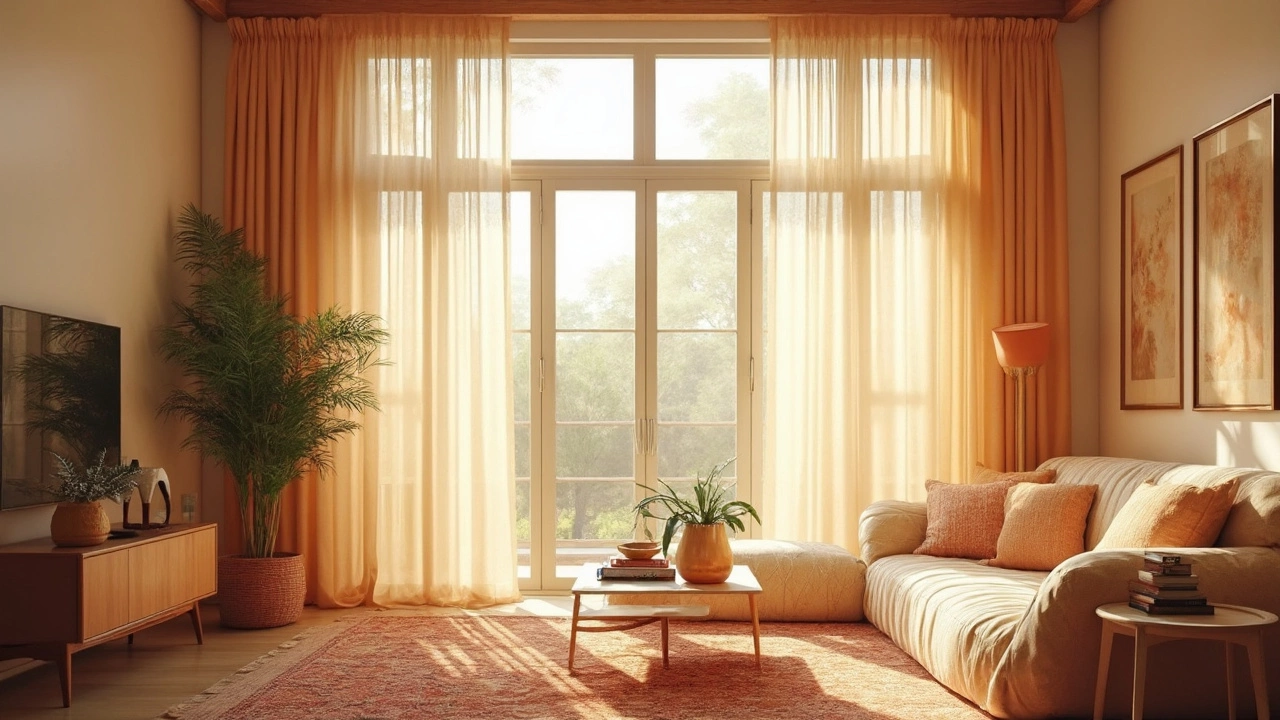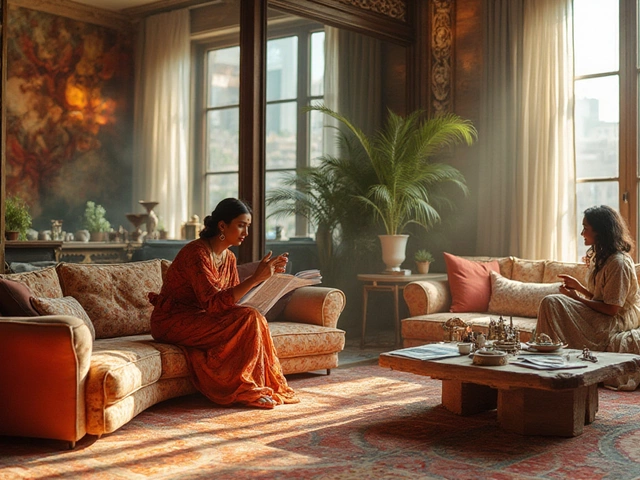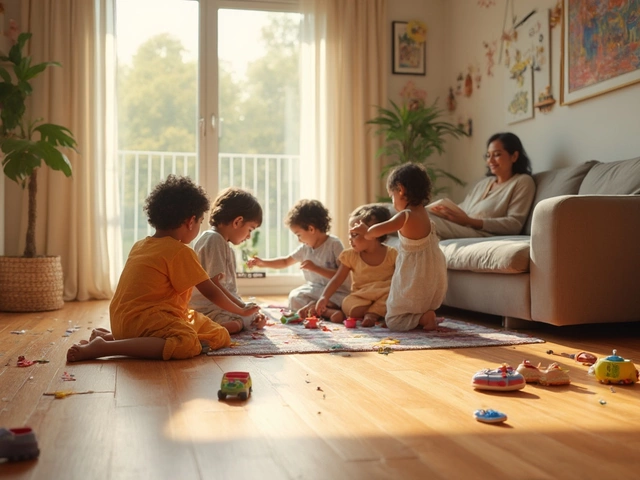Ever walked into a room and it just seemed to stretch out before you, even if it wasn’t all that big? It’s like magic—but really, it's all about smart design choices. One of those sneaky tricks? Choosing the right curtain color. The right hues can make a space feel a whole lot bigger than it actually is.
So, you might be wondering, what's the secret sauce here? Typically, lighter colors are the go-tos for creating that illusion of a more open, airy space. Think whites, soft grays, and pastels—they reflect more light and can make walls feel like they're farther apart. If your goal is to open up a room, ditching darker, heavier fabrics isn’t the worst idea
But wait, there’s more to it than just picking any light color. Understanding how it plays with the natural light in your room is super important. You want to make sure the daylight bounces right off those curtains, spreading throughout the room and banishing any shadows that make things feel cramped.
- Understanding Optical Illusions
- Choosing Light Colors
- Incorporating Patterns
- Playing with Light
- Material Matters
- Matching Walls and Curtains
Understanding Optical Illusions
Optical illusions in interior design are all about tricking our eyes into seeing something that might not be entirely accurate. Ever heard of the phrase "tricking the eye"? It’s all about using color, light, and patterns to change how we perceive space. The right curtains can play a huge part in this. Here's how it works.
Colors can manipulate perception by affecting depth and space. Light colors like white, cream, or pastel shades can make walls recede, giving the impression of a larger room. This is simply because lighter colors reflect more light, opening up the space and pushing back any visual boundaries.
Height is another dimension that’s ripe for manipulation. Vertical stripes, for example, draw the eyes upward, making the ceiling seem higher and the room taller. Who doesn’t want extra space, even if it’s just an illusion?
Then there’s the role of natural light. Light-filtering, sheer curtains allow more daylight to enter, reducing shadows that might make a room feel boxed in. Maximizing natural light with your curtain choice can completely transform how spacious a room feels.
Here's a quick look at the types of illusions you might be working with:
- Horizontal Illusions: Light colors can make a room feel wider as they reflect light and draw the eye across the room.
- Vertical Illusions: Patterns like vertical stripes or long curtains that extend from ceiling to floor can make ceilings seem higher.
- Light and Shadow: Using thin, sheer fabrics can soften shadows, making a space seem more open and airy.
Getting a handle on these illusions can be a game-changer for small rooms. All it takes is some clever color choice and fabric design, and you've got yourself a room that feels a whole lot bigger.
Choosing Light Colors
Picking the right curtain color can really make a difference in how roomy your space feels. Light colors like white, soft gray, and pastels are top choices when aiming for a bigger-looking room. These colors naturally reflect more light, bouncing it around the room and creating a sense of openness. Imagine your room catching a ray of sunshine and reflecting it all around, making everything feel larger and more inviting.
One neat trick is to match your curtains with your wall color. This seamless look reduces visual barriers, giving an uninterrupted flow that tricks the eye into perceiving more space. Think of it like a continuous canvas instead of fragmented picture frames.
But it’s not just about the lighter shades. Adding a pop of color can create an accent without overwhelming the space. For instance, if you love blues, opt for a soft blue that won’t darken the room but will give it a bit of personality. If you're feeling adventurous, try light yellow curtains for a cheerful vibe, yet keep them subtle enough to avoid any overpowering effects.
Also, consider the direction your room faces. North-facing rooms tend to be darker, so pairing them with warmer light colors can add a cozy brightness, while south-facing ones can handle cooler shades since they get more sunlight during the day.
Here’s a quick checklist for choosing light curtains:
- Match with wall colors for continuity.
- Choose warm shades like cream for darker rooms.
- Add a soft color accent if needed.
- Adapt curtain material to enhance light reflection.
Remember, the goal is to expand rather than overwhelm, allowing both the room and your personal taste to shine through.
Incorporating Patterns
Patterns—it’s not just about colors when making a room appear bigger; it’s also about what’s on those curtains. Patterns can be your best friend or your worst nightmare when it comes to space perception. For this magic trick to work, you need a little strategy.
Vertical patterns, like stripes, can make your ceilings seem way higher than they actually are. When the eye follows those vertical lines, it kinda gets the idea that the room is taller. Sounds simple, right? If you have low ceilings, this trick might just be the thing that makes them feel a bit more sky-high.
On the flip side, horizontal patterns aren’t always the enemy. They can elongate a room, much like how horizontal stripes on clothing can widen hips or shoulders. Just make sure to keep them subtle. Bold and loud patterns might overwhelm and make the space feel cluttered.
If you’re feeling a bit more adventurous, geometric patterns are another option. They can add depth when used cautiously, especially if they follow a simple and repetitive design. Avoid anything too busy, as it might have the opposite effect on your space, making it feel cramped.
Here's a quick rundown of pattern picks:
- Vertical stripes: Good for visually elevating ceilings.
- Subtle horizontal lines: Great for elongating a narrow room.
- Geometric patterns: Add depth but keep them simple.
Remember, balance is key. When it comes to patterns, you want them to complement, not compete with, the rest of your room’s decor.

Playing with Light
Think of your curtains as more than just window dressing. They're like strategic light bouncers, hard at work to make your room look brighter and more spacious. But how do you nail that perfect lighting effect? It's all about leveraging natural light and picking curtains that complement it.
First up: sheer curtains. They let in tons of natural light without sacrificing privacy. If you've ever walked into a room with sheer curtains, you've felt how daylight floods the space, making it feel less crowded. It's almost like erasing boundaries.
Let’s talk placement. You don’t want curtains that cut off light. Hang them higher and wider than the window frame. This way, when they’re open, they practically disappear, and the full window's light streams in. Your room will thank you by feeling more expansive.
Also, consider choosing curtain materials that work with your room’s lighting throughout the day. During daytime, colors can change based on how sunlight hits them. Knowing the direction your room faces can help too—a south-facing room gets strong light all day, while a north-facing one gets more gentle, steady light.
Oh, and pro tip: if you’re experimenting with darker colors or fabrics but still want an airy feel, pair them with a light-colored sheer. The sheer diffuses light, keeping your room bright while the darker curtain adds contrast.
By understanding how to manipulate light with curtain choice and placement, your space can transform dramatically. It's those small choices that pack the biggest punch in interior design.
Material Matters
When it comes to picking curtains that’ll make your room seem bigger, the material is just as important as the color. You can't overlook this. The right fabric can totally change how space feels—trust me on this one.
First off, there's sheer curtains. These are winners because they let in loads of light, keeping things bright and open. Since they’re kind of see-through, they don't block your view or cut off the room's flow. It's like having a barrier that isn’t really there.
Then you’ve got linen. It’s light but has more texture than sheer materials. Linen has a casual, breezy vibe that fits perfectly with lighter colors. Plus, it just feels homely and cozy without weighing the room down.
If you’re all about elegance, silk might grab your attention. It’s a tad heavier but still reflects light beautifully, adding a touch of glam without making things feel cramped.
Another pro tip: Avoid heavy, thick fabrics like velvet if you're trying to make space look larger. Sure, velvet feels luxurious, but it can make a room feel heavy and small. It's like wearing a wool sweater in summer—just too much.
To really up the ante, you should also think about the curtain hardware. Slimmer rods and minimalist styles don’t distract from the broad, airy feeling you’re going for. Keep things simple, and let the magic of light and fabric do their thing.
These choices aren’t just about looks; they’re strategic. By being smart about materials and designs, you can turn even a small apartment into a spacious sanctuary. Go ahead, make those curtains count!
Matching Walls and Curtains
Think of your room as a harmonious symphony rather than a jumbled collection of furniture. When you're aiming for a spacious feel, matching your curtains to your walls can be a game-changer. By using similar colors, or shades from the same palette for both, you create a seamless visual flow that tricks the eye into perceiving a larger space.
For instance, if your walls are a soft beige, curtains in a slightly lighter or darker beige will blend beautifully, making the edges of the room disappear into each other. This effect is similar to painting a ceiling the same color as the walls—it tricks your eyes into seeing uninterrupted space.
And here’s a handy tip: if you want to add a hint of variety without breaking that flow, consider using textures rather than stark color contrasts. A slightly textured curtain, in the same color as your wall, can provide depth while still maintaining that expansive feel.
Pay attention to the light in the room as well. In rooms that bask in natural light, having matching light-colored walls and curtains can ensure that warm sunlight fills up the room, accentuating that open vibe. On the flip side, in areas lacking daylight, sticking to brighter, matching tones can help reflect artificial light around the room.
Here’s a little nugget of math magic: a study found that painting walls and curtains in similar shades can make the room feel up to 20% bigger. So if you're starved for space, this little trick could save the day.





